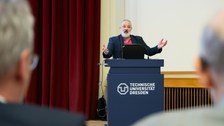12.10.2023
König-Bau mit der Historischen Farbstoffsammlung der TU Dresden als „Historische Stätte der Chemie“ ausgezeichnet

Von l.n.r. Prof. Jan J. Weigand, Kirsten Vincenz, Jan Gerken und Dr. Andreas Handschuh vor der Gedenktafel am König-Bau.
Mit einer feierlichen Festveranstaltung wurde der König-Bau der TU Dresden mit der Historischen Farbstoffsammlung am heutigen Donnerstag, 12. Oktober 2023, in das Programm „Historische Stätten der Chemie“ der Gesellschaft Deutscher Chemiker (GDCh) aufgenommen. Der historische Gebäudekomplex mit der europaweit einzigartigen Farbstoffsammlung wird als herausragender und einzigartiger Ort farbchemischer Forschung geehrt und erhält damit eine überregionale Würdigung, die bisher nur wenigen Universtäten in Deutschland zuteilwurde.
Die Farbstoffsammlung in ihrem noch original erhaltenen historischen Interieur im König-Bau auf dem Kerncampus der TU Dresden ist europaweit einzigartig. Als eine der bedeutendsten Sammlungen der Universität beherbergt sie mehr als 8.000 Naturfarbstoffe aus pflanzlichen und tierischen Quellen, über 18.000 nach ihrer chemischen Struktur geordnete Handelsmuster synthetischer Farbstoffe von mehr als 80 Herstellern sowie über 2.000 Farbmusterkarten und zahlreiche Färbemuster. Die ältesten Farbproben stammen aus der Zeit um 1830, andere Musterproben von der Weltausstellung 1851. Bis heute befindet sich die Sammlung in den 1926 bezogenen Sammlungsräumen im König-Bau der TU Dresden, an die sich ein farbenchemisches Labor und der historische Hörsaal anschließen.
Die Gesellschaft Deutscher Chemiker (GDCh) würdigt die Einzigartigkeit und besondere Bedeutung dieses akademischen Erbes durch die Auszeichnung „Historische Stätte der Chemie“, die mit einer feierlichen Festveranstaltung auf dem Campus der TU Dresden vergeben wurde. Begleitet von Grußworten der Prorektorin Universitätskultur der TU Dresden Prof.in Roswitha Böhm, Staatssekretär Dr. Andreas Handschuh, dem GDCh-Ortsverbandsvorsitzenden Dresden Prof. Jan J. Weigand und dem Dekan der Fakultät Chemie und Lebensmittelchemie Prof. Stefan Kaskel, fand zu diesem Anlass auch ein wissenschaftliches Programm mit Fachvorträgen von u.a. dem Sammlungsbeauftragten der Farbstoffsammlung Prof. em. Horst Hartmann und dem international ausgezeichneten TUD-Forscher Prof. Karl Leo statt. Im Anschluss wurde eine Gedenktafel durch den Kanzler der TU Dresden Jan Gerken und Prof. Jan J. Weigand enthüllt.
„Die Auszeichnung des König-Baus als herausragender und einzigartiger Ort farbchemischer Forschung im Programm ‘Historische Stätte der Chemie‘ der Gesellschaft Deutscher Chemiker bedeutet für die TUD eine überregionale Würdigung dieses Ortes auf unserem Kerncampus. Die Verleihung des Titels unterstützt unser Bemühen, historischen Bestand zu schützen und dauerhaft auf unserem Campus zu erhalten. Ich hoffe, dass der heutige Tag den Auftakt bildet für einen Weg der Bewahrung und bestmöglichen Erhaltung des historischen Erbes des König-Baus und seines Interieurs, um es für die Wissenschaft und die interessierte Öffentlichkeit dauerhaft zugänglich zu machen“, betont Prorektorin Böhm.
Und auch für Prof. Horst Hartmann, emeritierter Professor für Organische Chemie, und seit 2003 ehrenamtlicher Betreuer der Farbstoffsammlung an der Fakultät Chemie und Lebensmittelchemie ist die Auszeichnung eine besondere Ehre: „Durch die Auszeichnung wird der Blick der Öffentlichkeit auf eines der letzten an der Fakultät für Chemie und Lebensmittelchemie noch weitgehend im Originalzustand erhaltenen Gebäude gerichtet. An diesem Ort wurde über viele Jahrzehnte hinweg Spitzenforschung betrieben, die wesentlich, aber nicht ausschließlich, mit dem Namensgeber des Gebäudes verbunden ist. Dadurch wird meine Hoffnung gestärkt, dass der König-Bau auch künftig für die TU Dresden und auch die Öffentlichkeit ein Ort sein wird, in dem die Geschichte der Chemie und vielleicht auch einiger anderer bedeutsamer Wissenschaftsdisziplinen ansehens- und erlebenswert bleibt.“ Der leidenschaftliche Sammlungsbeauftragte Horst Hartmann (85) pflegt eine besonders enge Beziehung zu den Räumlichkeiten und den vielen tausend Farbstoffen. Die Frage nach seinem persönlichen Favoriten kann er angesichts der Fülle und Einzigartigkeit nicht eindeutig beantworten: „Da geht es mir wie einem kinderreichen Familienvater, der danach gefragt wird, welches das liebste Kind seiner Familie sei.“
Mehr Informationen:
Historische Farbstoffsammlung
König-Bau

© GDCh/ Sven Döring

© GDCh/ Sven Döring

© GDCh/ Sven Döring
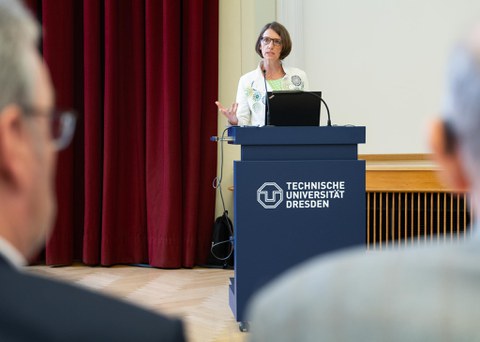
© GDCh/ Sven Döring

© GDCh/ Sven Döring

© GDCh/ Sven Döring

© GDCh/ Sven Döring

© GDCh/ Sven Döring

© GDCh/ Sven Döring

© GDCh/ Sven Döring

© GDCh/ Sven Döring

© GDCh/ Sven Döring

© GDCh/ Sven Döring

© GDCh/ Sven Döring
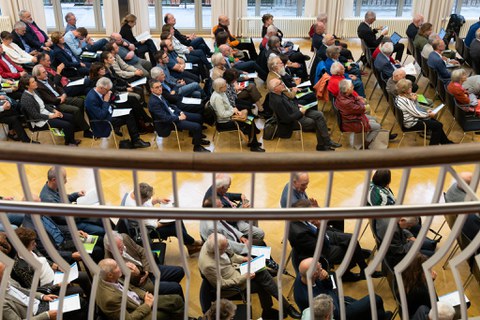
© Sven Döring

© GDCh/ Sven Döring

© GDCh/ Sven Döring

© GDCh/ Sven Döring
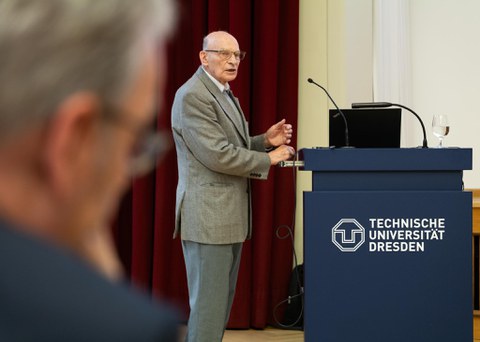
© GDCh/ Sven Döring

© GDCh/ Sven Döring

© GDCh/ Sven Döring
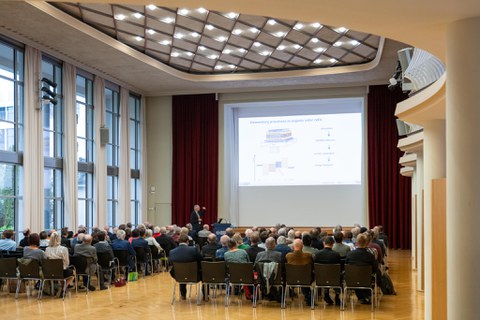
© GDCh/ Sven Döring

© GDCh/ Sven Döring

© GDCh/ Sven Döring
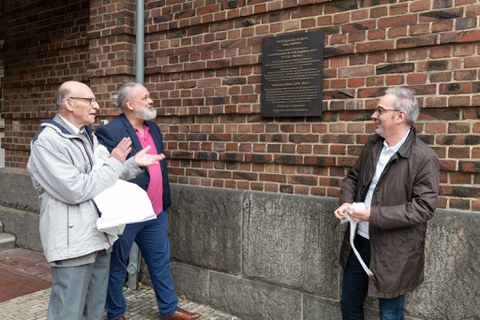
© GDCh/ Sven Döring

© GDCh/ Sven Döring

© GDCh/ Sven Döring

© GDCh/ Sven Döring

© GDCh/ Sven Döring

© GDCh/ Sven Döring

© GDCh/ Sven Döring
Video:
Über die GDCh:
Die Gesellschaft Deutscher Chemiker (GDCh) ist mit rund 30.000 Mitgliedern eine der größten chemiewissenschaftlichen Gesellschaften weltweit. Mit dem Programm "Historische Stätten der Chemie" würdigt die Gesellschaft Deutscher Chemiker (GDCh) seit 1999 Leistungen von geschichtlichem Rang in der Chemie. Als Orte der Erinnerung werden Wirkungsstätten bedeutender Wissenschaftler und Wissenschaftlerinnen in einem feierlichen Akt ausgezeichnet. Ziel dieses Programms ist es, die Erinnerung an das kulturelle Erbe der Chemie wach zu halten und die Chemie und ihre historischen Wurzeln stärker in das Blickfeld der Öffentlichkeit zu rücken.
Mehr Informationen:
https://www.gdch.de/gdch/historische-staetten-der-chemie/anmeldung-verleihung-dresden.html
Kontakt:
Kirsten Vincenz
Kustodie
TU Dresden
Tel. +49 351 463-32180








